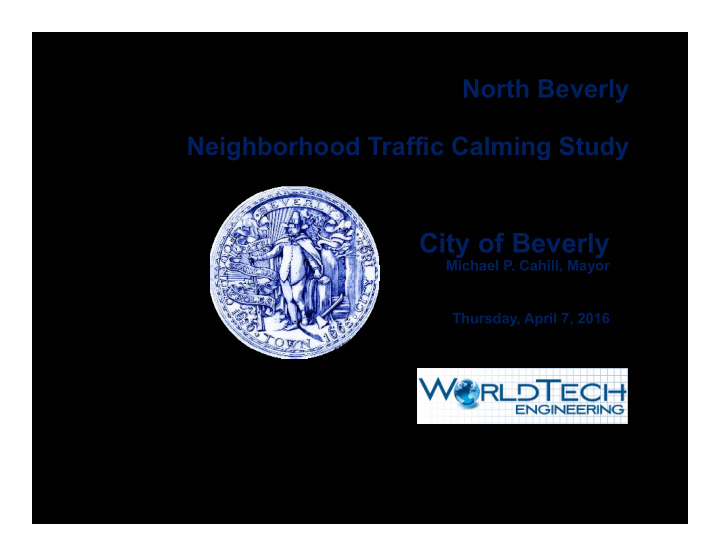



North Beverly Neighborhood Traffic Calming Study City of Beverly Michael P. Cahill, Mayor Thursday, April 7, 2016
AGENDA Introduction Project Background Community Concerns Traffic Calming Alternatives Data Collection & Findings Feedback Next Steps
PROJECT BACKGROUND Signalized Intersection Side Street Stop‐controlled
PROJECT BACKGROUND Henry’s Corner Signalized Intersection Long queues and delays. Drivers using the neighborhood network as cut-through to avoid congested intersection. By request of neighborhood residents through Councilor Martin over traffic concerns, City of Beverly conducted a Traffic Calming Study.
COMMUNITY CONCERNS Arterial traffic now using local streets. Speeding through the neighborhood. Safety of pedestrians and children walking within the neighborhood.
TRAFFIC CALMING “The combination of mainly physical measures that reduce the negative effects of motor vehicle use, alter driver behavior, and improve conditions for non-motorized street users” ( ITE Journal , July 1997) “An attempt to strike a balance between vehicular traffic and everyone else who uses the street” ( Slow Down, You’re Going Too Fast! The Community Guide to Traffic Calming , Public Technology, Inc., 1998) “Restore streets to their intended function” (ITE Canadian Guide to Neighbourhood Traffic Calming , December 1998)
TYPES OF TRAFFIC CALMING Vertical Deflection Horizontal Deflection Narrowings Volume Control Measures (Closures) Non-Physical Measures
VERTICAL DEFLECTION Speed Bumps Circular bump forcing a near-stop condition Design speed <5 mph Suited to driveways, parking lots Not for roadways
VERTICAL DEFLECTION Speed Humps Parabolic hump forcing significantly slower speed Used in sequence Best suited to local streets, collectors
VERTICAL DEFLECTION Speed Lumps Variation on Speed Hump Less severe deflection Wheel paths allow emergency vehicles to pass through Best suited to local streets, collectors
VERTICAL DEFLECTION Speed Tables (Raised Tables) Like speed humps, but used at intersections and in areas of high pedestrian activity Higher speed than speed humps; can be used on minor arterials Also Raised Crosswalks, Raised Intersections
HORIZONTAL DEFLECTION Chicanes/Lateral Shifts Diversion in Roadway Alignment Deflection at least 45°, one lane width Can be accomplished with parking Best suited to local streets, CBDs
HORIZONTAL DEFLECTION Chokers Reduce two-lane roadway to a single lane Similar to Chicanes Appropriate for local streets
HORIZONTAL DEFLECTION Neighborhood Traffic Circle Diversion in horizontal alignment at an intersection Little or no modification to corner radii Restricted to intersections; little impact on midblock speeds Appropriate for local streets
HORIZONTAL DEFLECTION Roundabouts Circular intersection, typically 100 to 250 ft in diameter Incoming traffic yields to circulating traffic Single lane or multi-lane Circulating speeds of 15 to 25 mph Appropriate for collectors and arterials
NARROWINGS Neckdowns / Curb Extensions Reduce speeds through driver perception of reduced roadway width Occupies normally unused space Shortens crossing distances
NARROWINGS Gateway Combination of Neckdowns & Median Communicates a change in speed, area type, or functional classification Can be used for landscaping/wayfinding
VOLUME CONTROL MEASURES One-Way Streets Full/Half Closures Diverters Right-in / Right-out Cul-de-Sacs
VOLUME CONTROL MEASURES Discourages cut-through traffic May inconvenience residents Must have viable alternate routes
NON‐PHYSICAL MEASURES Radar feedback signs Captures drivers’ attention Appropriate for any roadway class Useful at speed transition zones Should be used to address specific concerns (existing speeding problem, speed-related crashes, curves, School/Work Zones) Data collection and real-time monitoring
NON‐PHYSICAL MEASURES Enforcement Consumes valuable resources Cannot be active 100 percent of the time
NON‐PHYSICAL MEASURES STOP Signs NOT an effective traffic calming measure MUTCD: “YIELD or STOP Signs should not be used for speed control.” Massachusetts Amendments: “STOP or YIELD signs are not intended for and shall not be used for speed control.”
SELECTING TRAFFIC CALMING FEATURES 1. Problem Definition Speeding Cut-through Traffic Safety Context Micro vs. Macro
SELECTING TRAFFIC CALMING FEATURES 1. Problem Definition 2. Roadway Classification Local / Collector / Arterial Transit / Emergency Response Routes
SELECTING TRAFFIC CALMING FEATURES 1. Problem Definition 2. Roadway Classification 3. Scope / Budget of Project Low Cost/Quick Fix Long Term Reconstruction Spot Treatment or Area wide
SELECTING TRAFFIC CALMING FEATURES 1. Problem Definition 2. Roadway Classification 3. Scope/Budget of Project 4. Monitoring and Follow-up Immediate, 6 month, 12 month Volume, Speed, Crashes Emergency Response Times
STUDY AREA Signalized Intersection Side Street Stop‐controlled
EXISTING CONDITIONS Cabot Street at Dodge Street, County Way, Longmeadow Road, Scott Street Po Poor D Drainage Southb Southbou ound nd All All Appr Approaches L ches LOS S queues e queues extend nd E or F during E or F duri ng peak peak through R through Rout ute 1 e 128 28 periods periods Int Interchange rchange Narrow Side Narro Sidewalks, lks, No Separation No Separation w/Gas Stat w/Gas S ation No Crossw No Crosswalk alk Cr Crossw osswalk length – alk length – 103 f 03 ft Po Poor S Signal H Head No Crosswalk No Crossw alk Alignm ignment ent Confusing lane Confu ing lane Ramps no Ramps not AD t ADA A assignment assignment Com Compliant liant
DATA COLLECTION 2016 two‐way average daily traffic (ADT) volumes
DATA COLLECTION 1 2016 Morning (Evening) Peak Hour Turning Volumes
CUT‐THROUGH TRAFFIC 2016 Morning (Evening) Cut‐Through Volumes
TRAVEL SPEEDS 85 th –ile Speed STREET Direction Average Speed Prima Fascie (MPH) (MPH) Speed Limit Princeton Ave WB 22 26 30 EB 20 22 Tremont St NB 21 23 30 SB 22 25 Ellsworth Ave WB 24 27 30 EB 24 28 Clifton Ave WB 20 23 30 EB 20 23 Nursery St NB 18 20 30 SB 19 21 Dartmouth St NB 18 22 30 SB 21 27
NEXT STEPS 1. Henry’s Corner Intersection project update • Work on this intersection has been approved by the Project Review Committee, • Evaluated by Boston Region MPO, Scored 66 out of 134 points, project ranked #6 in the region, • Survey / Design pending. Multi-year process. 2. Needs Assessment Report for Neighborhood • Data presented today, • Crash Data, Parking, Pedestrian Volumes, etc. 3. Traffic Calming Report • Evaluation of Traffic Calming Alternatives, • Construction and Maintenance Cost. 4. Conceptual Plans
Discussion / Discussion / Questions Discussion / Discussion / Questions Questions Questions
Recommend
More recommend